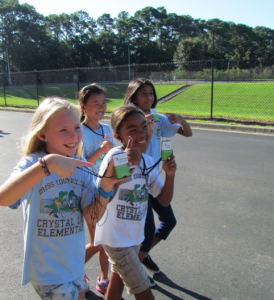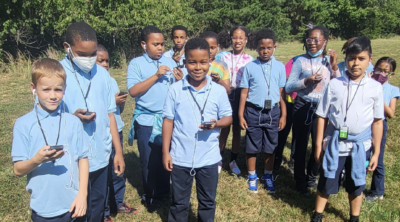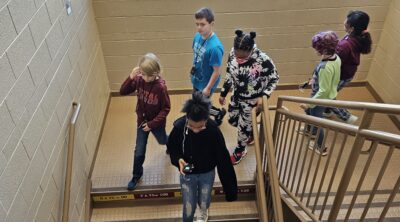You’ve started off the school year smoothly. Classroom expectations have been clearly conveyed. You’ve even finished preparing to start your implementation of The Walking Classroom, and you’re hopeful that you’ll hit the trail without a hitch.
And then . . . despite all your planning and preparation . . . it happens. The idyllic image in your mind’s eye — a line of smiling students walking, listening, and learning on a lovely autumn day — gets bumped out of view by a student’s less than stellar behavior. How do you handle the hampering that’s happening? We (thanks to some of your fellow adopters) can help you out with some best practices we’ve compiled.
First and Foremost, Keep the Faith!
Be bolstered by what is known about the benefits of physical activity! Everyone knows that regular exercise is good for the body. Research has shown that it is good for the mind as well! There is strong evidence for a positive link between exercise and cognitive function.
 In addition, research reveals that exercise is also one of the most effective ways to improve mental health. Regular exercise can relieve stress, improve memory, and boost overall mood. Our adopters’ personal experience with the program says much of the same! Teachers regularly report that students with behavior problems and/or high energy levels feel more settled and ready to keep learning following a walk!
In addition, research reveals that exercise is also one of the most effective ways to improve mental health. Regular exercise can relieve stress, improve memory, and boost overall mood. Our adopters’ personal experience with the program says much of the same! Teachers regularly report that students with behavior problems and/or high energy levels feel more settled and ready to keep learning following a walk!
Perhaps, just the regular repetition of this activity will soften your strong-willed students. Once they do engage, it is often those previously difficult members of your crew who become the strongest proponents (rather than opponents!) of the program.
Some Basic Strategies
Often the students who cause the most trouble in class are the ones who benefit the most from the extra physical activity walking provides. In the beginning, you may be worried about those troublesome students and how they’ll behave during The Walking Classroom.
To be honest, it may not only be these students who march to their own drummer at the outset. All students will probably be a bit excited and may behave somewhat erratically when you first start. No worries though! Soon the novelty will wear off, and students will learn the routine and organize themselves quickly. Don’t give up!
If, however, some students prove to be untrustworthy or too much of a distraction to other students, you may want to consider these useful strategies:
- Keep the troublesome child next to you as your walking partner. Your proximity will prove most helpful, as you model good walking behavior!
- Give that child the responsibility of mid-range pace car — his or her “job” would be to make sure that the other students are keeping up. Sometimes this added responsibility is all that challenging student needs to rise to the occasion!
- If all else fails, the child may need to wait in another teacher’s classroom while the rest of the class walks. Then you can give him or her a chance to try again at a later time.
Other Issues
![]() Maybe you have some students struggling because they do not enjoy physical activity and are feeling frustrated. Perhaps a conversation around such concerns and follow-up discussion focusing on the benefits of increased physical activity may help these students. Similarly, working toward a class step or mileage goal may inspire such students to try for the sake of the “team”!
Maybe you have some students struggling because they do not enjoy physical activity and are feeling frustrated. Perhaps a conversation around such concerns and follow-up discussion focusing on the benefits of increased physical activity may help these students. Similarly, working toward a class step or mileage goal may inspire such students to try for the sake of the “team”!
Two True Tales
 Finally, don’t think you’re alone in your trials and tribulations! We’ve all faced challenging children in our classrooms. From stubborn souls not interested in participating in the program to those who may have more energy than they (or you!) know what to do with, our adopters have seen it all, and are happy to share those strategies that have helped turn the tide!
Finally, don’t think you’re alone in your trials and tribulations! We’ve all faced challenging children in our classrooms. From stubborn souls not interested in participating in the program to those who may have more energy than they (or you!) know what to do with, our adopters have seen it all, and are happy to share those strategies that have helped turn the tide!






How I address behavior issues.
1. If the problem is severe, I have the student walk with me.
2. I have hand signals and audio signs that I use throughout the trip.
3. I give the students three questions before we begin the walk. The students are to listen for the answer. When we return we write down our answers in our journals and make a game out of it (prizes included).
4. I have a map on a bulletin board. The best behaved student gets to put a push pin in any location that they mentioned in the podcast.